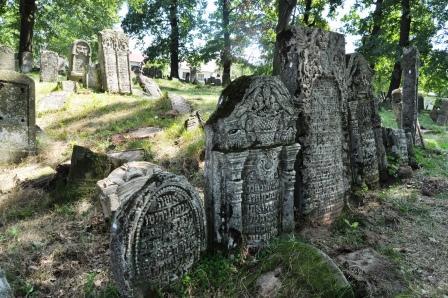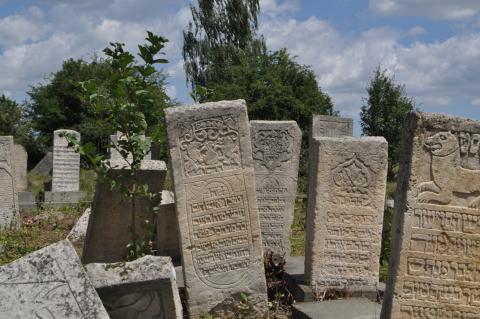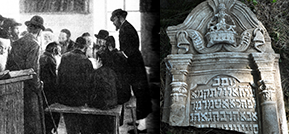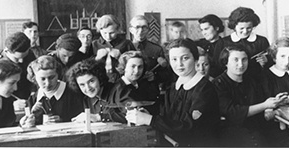The fifth expedition to East Galicia of the Association was composed of university and yeshiva students from Israel and Russia, including students from the “Siach Yitzchak” Hesder Yeshiva, Hebrew University students and students of Jewish Studies from the St. Petersburg and Moscow State Universities. It was guided by Drs. Boris Khaimovich and Ilia Lurie of the Hebrew University and Mrs. Marina Brook of St. Petersburg University.
The destination of this expedition was two towns in which large Jewish cemeteries have survived: Bolekhiv (Bolechów) and Pechenizhyn (Peczenizyn).
Pechenizhyn was a small town in the possession of a nobleman. We know that Jews resided there as early as the 18th century, since the wooden synagogue in the town, complete with its spectacular wall paintings, dates to this time. The population of the town – both Jewish and non-Jewish – grew significantly following the discovery of oil wells at the end of the 19th century. In 1890 there were 2,224 Jews in Pechenizhyn (out of 6,838 inhabitants), but with the decrease in oil production the Jewish population of the town dwindled, with many leaving for other locations in Galicia or abroad. During the Holocaust the Jews of Pechenizhyn were deported to the Kołomyja ghetto, where they died together with the Jews of Kolomyja.
The only witness to the former Jewish life of this town is an old cemetery, situated on the hill across the river from Pechenizhyn. Decades of neglect led to large parts of the cemetery being grown over by plants and trees; therefore cleaning and preparation work was undertaken before the arrival of the expedition. This enabled the approach of expedition members to the entire cemetery and the documentation of all of the surviving tombstones. All in all, 700 tombstones, dating from the mid-18th century until 1939, were documented. Many of these had sunk into the ground, and expedition members were often forced to dig them out and remove layers of greenery, ash and weeds in order to document them. Some had fallen over and broken over the years and needed to be turned over in order to reveal the decorated side of the tombstone. As a result of the work undertaken in the Pechenizhyn cemetery, we have established that it is the largest and best preserved of the Jewish cemeteries in Pokutie (the Kolomyja region). It enables a rare view into the unique social and artistic life of the Jews of the region, from the 18th century until the Holocaust. Different artistic trends, representative of the Jews of Galicia in different periods, are well expressed in the tombstones documented by the expedition.
Bolekhiv, to which the expedition turned after completing its work in Pechenizhyn, is a representative of a completely different type of Jewish settlement. Bolekhiv was a relatively large city, established at the beginning of the 17th century, which served as an important center of social and economic life in the Dolina region. Jews inhabited the city from its inception, and during the second half of the 19th century comprised about 75% of its population (3,323 out of 4,237 inhabitants in 1890). Among the Jewish inhabitants of Bolekhiv were those involved in major trade and industry (particularly tanning), scholars and famous rabbis. Jews played an extremely important role in the city’s economic and public life, and in 1874 Israel Hauptman, the Jewish owner of the city’s tanning factory, was elected mayor. One of the most notable figures in Bolechów’s Jewish community was the wine trader and public figure Dov Ber Birkenthal (1723-1805), the author of a memoir which serves as an important source of data regarding Jewish life in the Polish-Lithuanian kingdom during its final years. The Jewish Enlightenment and processes of modernization reached Bolechów in the 19th century, finding expression in the activities of a local chapter of the Enlightenment movement, which managed to take over communal leadership, and in the establishment of the progressive Jewish school in the city in the 1850s. Alongside these developments, the majority of the Jewish population of Bolekhiv continued its traditional lifestyle and was even influenced by the spread of Hasidism. In the city center, near the marketplace, where Jewish life was centered, a large fortress-like synagogue was built at the beginning of the 19th century; near it operated several halls of study and Hasidic kloizes.
Following the killing of all of Bolekhiv’s Jews by the Nazis, not many testimonies to the formerly vibrant Jewish life of the city remained. The large synagogue served as a worker’s club and the old cemetery was targeted by acts of vandalism by local inhabitants. Only recently have various Jewish organizations initiated the fencing in of the cemetery and the refurbishing of the synagogue.
The purpose of the expedition in Bolekhiv was the full documentation of the tombstones in the cemetery and the identification and documentation of locations connected to the Jewish life of the city.
Already on the first day of work in Bolechów, it became evident that the cemetery was a large one, much more so than implied by the descriptions of previous scholars (expedition members estimated that around 1,500 tombstones remained). Many tombstones were sunk in the ground and covered by ash and weeds, some were overturned. The members of the expedition took great pains to uncover and document these. Among the tombstones documented were those of Dov Ber Birkenthal and his family, those of various famous rabbis and scholars, that of Israel Hauptman and others. Many of the tombstones testify to the high cultural and artistic level the community maintained from the end of the 17th century and through the beginning of the 20th. They comprise an unparalleled artistic collection, no less important than collections from Jewish cemeteries in central Europe, both in quantity and in quality. The expedition documented about half of the tombstones (about 750) in the cemetery and plans to return next year to document the rest.
As mentioned above, the city was also surveyed in order to identify significant sites relating to the city’s Jewish past. Based on testimonies of Bolekhiv descendants and veteran locals, a number of buildings formerly owned by Jews or housing Jewish institutions were located and documented.
All of the findings of the expedition, including descriptions and pictures, have been uploaded to the website.

Bolechow cemetery

Pechenezhin cemetery






